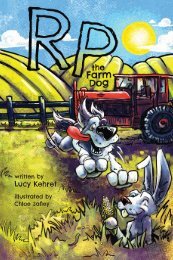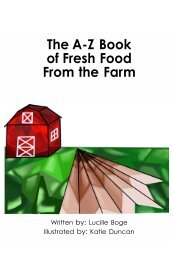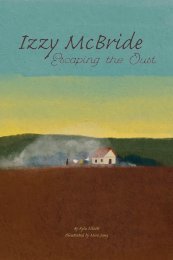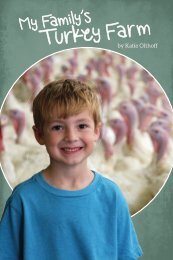My Family's Dairy Farm
Meet Lucas, an 8-year-old who helps with his family's dairy farm. Learn how farmers produce milk that can be made into cheese and other dairy products. As he takes you on a tour of his family's dairy farm, see through his eyes how they sustainably raise and care for cows.
Meet Lucas, an 8-year-old who helps with his family's dairy farm. Learn how farmers produce milk that can be made into cheese and other dairy products. As he takes you on a tour of his family's dairy farm, see through his eyes how they sustainably raise and care for cows.
Create successful ePaper yourself
Turn your PDF publications into a flip-book with our unique Google optimized e-Paper software.
by Katie Olthoff
My Family’s Dairy Farm
Written by Katie Olthoff
Photographed by Jenn Hindman
Printed as a special project of:
Iowa Agriculture Literacy Foundation
Midwest Dairy
Iowa Agriculture
Literacy Foundation
Hi, my name is Lucas,
and this is my family’s
farm. We raise
corn, alfalfa, and
dairy cattle.
Lucas’s grandparents had about 80 cows. Then, the farm expanded in 1997 to
350 cows. Over the years, the family has built more dairy barns and added
cows. Now, they have about 1,100 cows on the farm!
Dairy farmers focus on sustainable nutrition. Their goal is to create a
nutritious food that is good for the planet and the community.
2
3
Dairy cattle are very calm animals, but they
require a lot of care.
We make sure they have feed and water.
We also make sure they are comfortable.
See the soft beds where they are laying?
And see the big fans that keep them cool?
The barn keeps them warm in the winter
and cool in the summer.
Each of our cows
has a baby calf
every year. After
the cow gives birth,
its body starts
making milk.
Lucas’s family raises jersey cows. Jerseys are usually brown and are great at
making milk. Another popular breed of dairy cattle in the U.S. is Holstein.
Holsteins are black and white.
Cows make milk to feed their calves and continue producing milk as long as
they are regularly milked.
Many of the baby calves will grow up to become mothers themselves and
become part of the milking herd.
4
5
Cow’s milk provides us with many important
nutrients. It is a great source of protein,
calcium, and Vitamin B12.
The milk from cows can also be made into
yogurt, ice cream, and butter. Most of the
milk from our farm is made into cheese.
Jersey cows make milk that is high in fat and protein. Protein helps build and
repair muscle tissue. Calcium helps build and maintain strong bones and teeth.
Vitamin B12 helps with normal blood functions and helps keep the nervous
system healthy.
Cheese is made from milk that contains a lot of fat and protein, like the milk
from Lucas’s farm. Nearly half (48%) of all milk is used to make cheese.
6
7
Our cows spend about half of the day
lying down, but they’re not lazy! Their
bodies are always making milk!
Three times a day, they line up to get
milked. When we open the gate, they know
exactly where to go!
The cows are milked at 4:30 a.m., 12:15 p.m., and 8:30 p.m. Cows like having a
steady routine.
8
9
They head to the milking parlor. Then, each
teat is washed with soap.
We attach all four teats to the milk machine.
The machine gently sucks the milk out of
the udder.
Three times a day, the milking parlor is cleaned to keep the milk safe. Using
state-of-the-art equipment prevents contamination. Food safety is one of the
top priorities for farmers.
10
11
The whole process takes about 5 minutes.
See those computer screens? They keep
track of how much milk comes from each cow.
Each of our cows makes about 55 pounds
of milk each day. That’s almost 7 gallons -
enough to fill 112 little cartons of milk like
the ones at school!
Each cow has an ear tag with an electronic ID. This is like a nametag that can be
read by a computer.
When the cow is milked, the computers keep track of how much milk is
produced. If a cow is making less milk than normal, it tells the farmer that
something might be wrong.
If that happens, the cow is guided to an area where it can be assessed for any
health issues.
12
13
Our cows have to eat a lot to be healthy.
It takes about 1 acre of farmland to grow
the alfalfa and corn needed for 1 cow.
We mix together
feed ingredients
using recipes
called rations.
The rations
change as the
cows get older.
The rations give the cattle exactly the right
nutrients that they need. And they love it!
Dairy farmers consult with an animal nutritionist, to help determine
which feed rations should be used. A well-balanced ration helps keep the
cattle healthy.
Veterinarians also monitor the cattle and treat illness when needed.
14
15
After the milk is collected, it is filtered
and cooled. Then it is hauled away to the
processor. The processor will make our
milk into cheese.
The milk truck comes once a day to pick
up the milk. Before loading up the truck,
we test the milk for safety.
Then, the milk is tested again at the
processor.
If there is anything in the milk that might
make people sick, it is not used.
If a cow is sick, it might need medicine like antibiotics. In that case, the cow
will be milked in a different area and the milk will be not be used. This ensures
that there are no antibiotics in milk that is sold for humans to drink.
Still, the milk is tested several times before it goes to the store or gets made
into cheese. In addition to testing for antibiotics, it is also tested for harmful
bacteria. The protein and fat content can also be measured through testing.
Milk can go from the farm to grocery store shelves in about 2 days. Cheese
takes a little bit longer to make.
16
17
Keeping these barns clean is a big
part of our job!
In most of our barns, the cattle
manure drops down through slats in
the floor. It is stored underground in
really big tanks until we can spread it
on our fields. It makes great fertilizer
for plants!
18
In addition to using manure as fertilizer, it can also be recycled by squeezing
out the water from the solid plant matter. Some dairy farms use sand to make
beds for the cows. But Lucas’s family uses the dried manure, which is really
just plant matter that wasn’t digested by the cows.
Some dairy farms even dry the manure and use it to make biodegradable
flower pots. Others use the manure to produce biogas, which can be used for
electricity, heat, natural gas or vehicle fuel.
19
Using manure as fertilizer is one way we
take care of the environment. We also
recycle water on our farm, and plant
cover crops to improve soil health.
We even have a farm pond that catches
the water from the driveways. Wildlife like
muskrats live there!
Taking care of
the environment,
recycling, and making
more food with
fewer resources
are all important
to my family.
Cows drink up to 40 gallons of water per day, so dairy farmers work hard to
conserve water.
On Lucas’s farm, the water is first used to cool the milk before the cows drink
it. The cold water and warm milk flow through different parts of the same
machine. The water is warmed up by the milk and the milk is cooled down by
the water.
Then, the 70ºF water flows to tanks for the cows to drink from. The cows
prefer the warmer water, even in the summer.
In addition to recycling water and manure, Lucas’s family uses soil
conservation techniques on their fields, and looks for ways for their farm to
be more efficient and sustainable.
20
21
Our family works together on our dairy
farm, along with several employees. The
employees help us take care of the cows
and milk them each day.
I love working with the cows, and I am proud
of the milk and cheese that comes from our
family farm.
22
Lucas’s family farm supports several jobs in their community. From the
milkers to the milk hauler to the processor’s employees, dairy farms are an
important part of rural economies.
Dairy farms have become much more efficient and sustainable since Lucas’s
grandparents began milking cows several decades ago. According to U.S. Dairy,
the environmental impact of producing a gallon of milk today involves 30%
less water, 21% less land, 21% less manure and a 19% smaller carbon footprint
than it did in 2007.
With innovative and dedicated farmers like Lucas’s family, the dairy farms of
the future are sure to make even more advancements and become even more
sustainable.
23
Glossary
ALFALFA: a plant that looks like clover and grows 2-3 feet tall; an
important ingredient in dairy cattle rations
ACRE: a unit of measuring land; about the size of a football field
CALCIUM: a mineral humans need for strong bones and teeth
CALF: a cow’s baby
COVER CROPS: a crop planted in the fall of the year to slow
erosion and improve soil health
COW: female cattle that have given birth to a calf
DAIRY CATTLE: cattle raised mostly for milk, but also for meat
DIGESTED: food broken down and used by the body for energy
or tissue growth
FARMER: someone who grows food or raises livestock
FEED: food for livestock
FERTILIZER: provides nutrients plants need to grow
MANURE: poop from animals
NUTRIENTS: something that plants, animals and people need to
live and grow
PROTEIN: a nutrient used by the human body for many things,
including building muscle; food made from animals, like meat
and milk, are great sources of protein
RATIONS: carefully balanced, nutritious diet that is developed
with a livestock nutritionist and changes as the cattle grow
SUSTAINABLE: raising food in a way that is environmentally
sound, economically viable and socially responsible; farmers
always consider sustainability when making decisions on their
farm
TEAT: the pointed part on the body of a female where milk
comes out
UDDER: the large bag shaped body part where milk is produced;
located on the underside of the cow
VETERINARIAN: a doctor for animals
VITAMIN B12: a vitamin found in milk that is essential for
healthy nerve and blood cells
24
25
Meet Lucas, an 8-year-old who helps with his family’s
dairy farm. Learn how farmers produce milk that can be made
into cheese and other dairy products. As he takes you on a
tour of his family’s dairy farm, see through his eyes how they
sustainably raise and care for cows.
ADDITIONAL RESOURCES:
www.iowaagliteracy.org

















